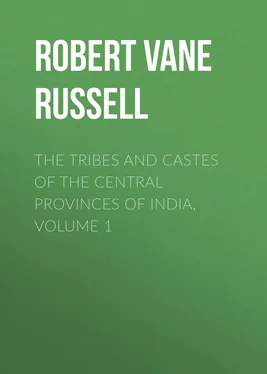Robert Vane Russell - The Tribes and Castes of the Central Provinces of India, Volume 1
Здесь есть возможность читать онлайн «Robert Vane Russell - The Tribes and Castes of the Central Provinces of India, Volume 1» — ознакомительный отрывок электронной книги совершенно бесплатно, а после прочтения отрывка купить полную версию. В некоторых случаях можно слушать аудио, скачать через торрент в формате fb2 и присутствует краткое содержание. Жанр: foreign_prose, История, foreign_edu, foreign_antique, на английском языке. Описание произведения, (предисловие) а так же отзывы посетителей доступны на портале библиотеки ЛибКат.
- Название:The Tribes and Castes of the Central Provinces of India, Volume 1
- Автор:
- Жанр:
- Год:неизвестен
- ISBN:нет данных
- Рейтинг книги:5 / 5. Голосов: 1
-
Избранное:Добавить в избранное
- Отзывы:
-
Ваша оценка:
- 100
- 1
- 2
- 3
- 4
- 5
The Tribes and Castes of the Central Provinces of India, Volume 1: краткое содержание, описание и аннотация
Предлагаем к чтению аннотацию, описание, краткое содержание или предисловие (зависит от того, что написал сам автор книги «The Tribes and Castes of the Central Provinces of India, Volume 1»). Если вы не нашли необходимую информацию о книге — напишите в комментариях, мы постараемся отыскать её.
The Tribes and Castes of the Central Provinces of India, Volume 1 — читать онлайн ознакомительный отрывок
Ниже представлен текст книги, разбитый по страницам. Система сохранения места последней прочитанной страницы, позволяет с удобством читать онлайн бесплатно книгу «The Tribes and Castes of the Central Provinces of India, Volume 1», без необходимости каждый раз заново искать на чём Вы остановились. Поставьте закладку, и сможете в любой момент перейти на страницу, на которой закончили чтение.
Интервал:
Закладка:
“Thus their existence as a distinct nation is established in the neighbourhood of the Indus, that is to say in the region in which, in the oldest time, the Aryan Indians dwelt. The Aryans probably conquered these indigenous inhabitants first; and when the others in the interior of the country were subsequently subdued and enslaved, the name Sūdra was extended to the whole servile caste. There seems to have been some hesitation in the Aryan community about the actual religious position to be given to the Sūdras. In the time of the liturgical Brāhmanas of the Vedas, they were sometimes admitted to take part in the Aryan sacrifices. Not long afterwards, when the conquests of the Aryans were greatly extended, and they formed a settled state of society among the affluents of the Jumna and Ganges, the Sūdras were degraded to the humiliating and painful position which they occupy in Manu. There is no mention of any of the Sankara or mixed castes in the Vedas.” 26 26 Wilson, pp. 113, 114.
From the above evidence it seems clear that the Sūdras were really the indigenous inhabitants of India, who were subdued by the Aryans as they gradually penetrated into India. When the conquering race began to settle in the land, the indigenous tribes, or such of them as did not retire before the invaders into the still unconquered interior, became a class of menials and labourers, as the Amalekites were to the children of Israel. The Sūdras were the same people as the Dasyus of the hymns, after they had begun to live in villages with the Aryans, and had to be admitted, though in the most humiliating fashion, into the Aryan polity. But the hostility between the Aryas and the Dasyus or Sūdras, though in reality racial, was felt and expressed on religious grounds, and probably the Aryans had no real idea of what is now understood by difference of race or deterioration of type from mixture of races. The Sūdras were despised and hated as worshippers of a hostile god. They could not join in the sacrifices by which the Aryans renewed and cemented their kinship with their god and with each other; hence they were outlaws towards whom no social obligations existed. It would have been quite right and proper that they should be utterly destroyed, precisely as the Israelites thought that Jehovah had commanded them to destroy the Canaanites. But they were too numerous, and hence they were regarded as impure and made to live apart, so that they should not pollute the places of sacrifice, which among the Aryans included their dwelling-houses. It does not seem to have been the case that the Aryans had any regard for the preservation of the purity of their blood or colour. From an early period men of the three higher castes might take a Sūdra woman in marriage, and the ultimate result has been an almost complete fusion between the two races in the bulk of the population over the greater part of the country. Nevertheless the status of the Sūdra still remains attached to the large community of the impure castes formed from the indigenous tribes, who have settled in Hindu villages and entered the caste system. These are relegated to the most degrading and menial occupations, and their touch is regarded as conveying defilement like that of the Sūdras. 27 27 See for the impure castes para. 40 post .
The status of the Sūdras was not always considered so low, and they were sometimes held to rank above the mixed castes. And in modern times in Bengal Sūdra is quite a respectable term applied to certain artisan castes which there have a fairly good position. But neither were the indigenous tribes always reduced to the impure status. Their fortunes varied, and those who resisted subjection were probably sometimes accepted as allies. For instance, some of the most prominent of the Rājpūt clans are held to have been derived from the aboriginal 28 28 The word “aboriginal” is used here for convenience and not as conveying any assertion as to the origin of the pre-Aryan population.
tribes. On the Aryan expedition to southern India, which is preserved in the legend of Rāma, as related in the Rāmāyana, it is stated that Rāma was assisted by Hanumān with his army of apes. The reference is generally held to be to the fact that the Aryans had as auxiliaries some of the forest tribes, and these were consequently allies, and highly thought of, as shown by the legend and by their identification with the mighty god Hanumān. And at the present time the forest tribes who live separately from the Hindus in the jungle tracts are, as a rule, not regarded as impure. But this does not impair the identification of the Sūdras with those tribes who were reduced to subjection and serfdom in the Hindu villages, as shown by the evidence here given. The view has also been held that the Sūdras might have been a servile class already subject to the Aryans, who entered India with them. And in the old Pārsi or Persian community four classes existed, the Athornan or priest, the Rathestan or warrior, the Vasteriox or husbandman, and the Hutox or craftsman. 29 29 Bombay Gazetteer , Pārsis of Gujarāt , p. 213.
The second and third of these names closely resemble those of the corresponding Hindu classical castes, the Rājanya or Kshatriya and the Vaishya, while Athornan, the name for a priest, is the same as Atharvan, the Hindu name for a Brāhman versed in the Atharva-Veda. Possibly then Hutox may be connected with Sūdra, as h frequently changes into s . But on the other hand the facts that the Sūdras are not mentioned in the Vedas, and that they succeeded to the position of the Dasyus, the black hostile Indians, as well as the important place they fill in the later literature, seem to indicate clearly that they mainly consisted of the indigenous subject tribes. Whether the Aryans applied a name already existing in a servile class among themselves to the indigenous population whom they subdued, may be an uncertain point.
13. The Vaishya
In the Vedas, moreover, M. Senart shows that the three higher castes are not definitely distinguished; but there are three classes—the priests, the chiefs and the people, among whom the Aryans were comprised. The people are spoken of in the plural as the clans who followed the chiefs to battle. The word used is Visha. One verse speaks of the Vishas (clans) bowing before the chief (Rājan), who was preceded by a priest (Brāhman). Another verse says: “Favour the prayer (Brahma), favour the service; kill the Rakshasas, drive away the evil; favour the power ( khatra ) and favour the manly strength; favour the cow ( dherm , the representative of property) and favour the people (or house, visha ).” 30 30 Rig-Veda, 6. 3. 16, quoted by Wilson, Indian Caste , p. 110.
Hindu sculptures
Similarly Wilson states that in the time of the Vedas, visha (related to vesha , a house or district) signified the people in general; and Vaishya, its adjective, was afterwards applied to a householder, or that appertaining to an individual of the common people. The Latin vicus and the Greek οἶκος are the correspondents of vesha . 31 31 Wilson, p. 109.
The conclusion to be drawn is that the Aryans in the Vedas, like other early communities, were divided by rank or occupation into three classes—priests, nobles and the body of the people. The Vishas or clans afterwards became the Vaishyas or third classical caste. Before they entered India the Aryans were a migratory pastoral people, their domestic animals being the horse, cow, and perhaps the sheep and goat. The horse and cow were especially venerated, and hence were probably their chief means of support. The Vaishyas must therefore have been herdsmen and shepherds, and when they entered India and took to agriculture, the Vaishyas must have become cultivators. The word Vaishya signifies a man who occupies the soil, an agriculturist, or merchant. 32 32 Monier-Williams, Sanskrit Dictionary, pointed out by Mr. Crooke.
The word Vasteriox used by the ancestors of the Pārsis, which appears to correspond to Vaishya, also signifies a husbandman, as already seen. Dr. Max Müller states: “The three occupations of the Aryas in India were fighting, cultivating the soil and worshipping the gods. Those who fought the battles of the people would naturally acquire influence and rank, and their leaders appear in the Veda as Rājas or kings. Those who did not share in the fighting would occupy a more humble position; they were called Vish, Vaishyas or householders, and would no doubt have to contribute towards the maintenance of the armies. 33 33 Quoted by Wilson, p. 209. It would seem probable, however, that the Vaishyas must themselves have formed the rank and file of the fighting force, at least in the early period.
According to Manu, God ordained the tending of cattle, giving alms, sacrifice, study, trade, usury, and also agriculture for a Vaishya.” 34 34 Manu, i. 90.
The Sūtras state that agriculture, the keeping of cattle, and engaging in merchandise, as well as learning the Vedas, sacrificing for himself and giving alms, are the duties of a Vaishya. 35 35 Wilson, Indian Caste , p. 193, quoting from Hiranyakeshi Sūtra.
In the Mahābhārata it is laid down that the Vaishyas should devote themselves to agriculture, the keeping of cattle and liberality. 36 36 Wilson, p. 260, quoting Mahābhārata, viii. 1367 et seq .
In the same work the god Vayu says to Bhishma: “And it was Brahma’s ordinance that the Vaishya should sustain the three castes (Brāhman, Kshatriya and Vaishya) with money and corn; and that the Sūdra should serve them.” 37 37 Mahābhārata, xii. 2749 et seq .
Интервал:
Закладка:
Похожие книги на «The Tribes and Castes of the Central Provinces of India, Volume 1»
Представляем Вашему вниманию похожие книги на «The Tribes and Castes of the Central Provinces of India, Volume 1» списком для выбора. Мы отобрали схожую по названию и смыслу литературу в надежде предоставить читателям больше вариантов отыскать новые, интересные, ещё непрочитанные произведения.
Обсуждение, отзывы о книге «The Tribes and Castes of the Central Provinces of India, Volume 1» и просто собственные мнения читателей. Оставьте ваши комментарии, напишите, что Вы думаете о произведении, его смысле или главных героях. Укажите что конкретно понравилось, а что нет, и почему Вы так считаете.












